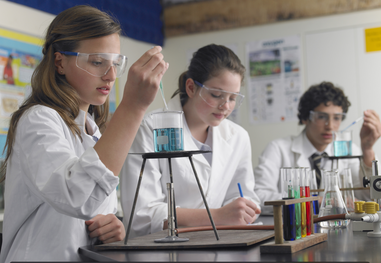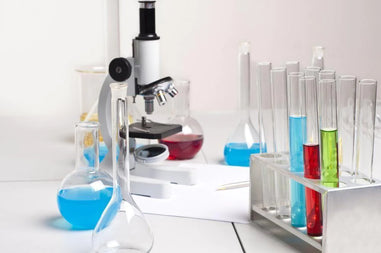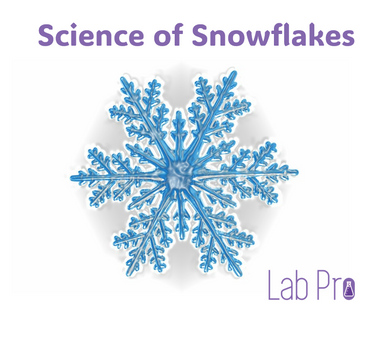The way a school science lab is set up will depend on the targeted age of the students. You will need to consider age-appropriate equipment and the arrangement of the room. No matter the age, the room should be set up with experimentation and collaboration in mind. The lab should have a technology storage area, a science library with unit-related books, and easy access to outlets.
Here we will cover the requirements and characteristics of an elementary science lab, age-appropriate equipment that should be included, safety procedures, and lab storage practices for elementary grades.
What do you need in an elementary grade chemistry lab?
Elementary grades need glassware, standard equipment, equipment used in titrations, and some miscellaneous instruments. The following items are considered the most practical apparatus for an elementary grade chemistry lab.
Glassware used for measuring:
Volumetric flask. A volumetric flask holds a precise volume at a certain temperature and is used for dilutions and preparation of solutions.
Graduated cylinder. Graduated cylinders are used to precisely measure the volume of liquids.
Pipette. A pipette is used for measuring or transferring small quantities of liquid.
Burette. Burettes measure the volume of a liquid or gas.
Erlenmeyer flask. Erlenmeyer flasks are used for holding liquids, mixing, heating, cooling, storage, filtration, and incubation.
Beaker. Beakers are used to hold liquids.
Test tube. Test tubes are used to hold, store, or mix liquids, chemicals, bodily fluids, and bacteria.
Vial with cap. Vials hold small amounts of liquids or solids.
Equipment often used in titrations:
Ring stand. Ring stands are used to hold glassware in place during an experiment.
Buret clamp. Buret clamps are devices that are adjustable and are used to secure burets to ring stands.
Utility clamp. Utility clamps are used to hold round lab glassware such as flasks and beakers.
Standard equipment:
Electronic scale. Electronic scales measure the mass of a substance more quickly and accurately than traditional scales.
Hot plate stirrer. A hot plate stirrer is used to heat and stir the solution simultaneously.
Centrifuge. Centrifuges are used to separate different liquids and solid particles from liquids and are also used for gasses.
Miscellaneous:
Funnel. Funnels are used to channel liquid or powder into a vessel without spillage.
Watch glass. A watch glass is used for evaporation, weighing solids, and as a lid for flasks and beakers.
Crucible tongs. Crucible tongs are used to hold hot equipment such as flasks, beakers, and crucibles. They are also used to handle dangerous chemicals.
Glass stir bar. Glass stir bars are used to stir solutions.
Magnetic stir bar. Magnetic stir bars are used to stir liquid in a sealed container.
Disposable pipet. Disposable pipettes are used to transport a measured volume of liquid.
Wash bottles. Wash bottles are used to rinse various pieces of glassware.
Pipet bulb. A pipette bulb is used as a vacuum to suck liquid from a vessel into the pipette.
Safety goggles. Safety goggles shield the eyes from chemical or liquid splash and irritating vapors and fumes.
Dessicator. A dessicator absorbs the moisture in chemical substances.
What are the characteristics of a good laboratory?
Efficient lab space. There should be lots of space for natural movement and flow. The tables should be uncluttered and conducive to experimentation and collaboration.
Sound safety precautions. You should have quick and easy access to safety equipment and a sound ventilation system.
Secure lab storage. Keep all chemicals labeled accurately and stored securely in a locked storage area.
Well-equipped. All labs should include all of the basic lab equipment such as glassware, microscopes, etc.
Organized. All science labs should remain uncluttered and organized for an efficient work flow and easy access to equipment.
Practicing chemical safety in an elementary chemistry lab: What safety equipment should be used in your elementary science lab?
Safety equipment should always be provided in an elementary chemistry lab to prevent injury and clean up spills.
Here’s a list of the protective equipment that should be easily accessible and always on hand:
Safety goggles. When there is a potential for a projectile or chemical hazard, American National Standards Institute Z87 or Z87.1 chemical splash goggles should be provided for each student.
Sanitizer for goggles. All goggle rims and straps should be wiped down with alcohol wipes to kill bacteria after each use.
Chemical-resistant aprons. When there is a possibility of spattering or spillage of hot water or chemicals, protective aprons should be provided to each student.
Safety gloves. When handling plants, soil samples, animals, material that contains harmful allergens or micro-organisms, or chemicals that cause staining or skin irritation, safety gloves should be provided for protection.
Eyewash stations. Eyewash stations should be placed within 10-15 seconds and 20-30 steps of students working in a lab. They should be low enough for elementary students to flush their eyes if a chemical or particle lands in an eye.
Fire extinguishers. An elementary chemistry lab should be equipped with a sufficient number of ABC tri-class fire extinguishers.
Body sprayers. Body sprayers should be foot or forearm-operated and are used to put out burning hair or clothing.
Grand fault interrupters/outlet covers. The outlet covers prevent objects from being inserted into an outlet. The grand fault interrupter breaks the circuit in order to prevent electrocution.
First-aid kit. First-aid kits should be easily accessible in case of an emergency.
Safety posters. Safety posters should be displayed throughout the room.
Elementary chemistry lab storage best practices
It’s important to label chemicals accurately and store them securely.
Store chemicals in a locked storage area and mark the storage area with NFPA warning symbols to show the highest rating of any chemical stored in each category. This will alert firefighters in case of an emergency.
Be sure to keep an updated inventory on file of every chemical in storage. To properly store and separate chemicals, use wooden shelves with front lips that prevent sliding. Flammables, bases, and acids should be stored in well ventilated and separate areas.
Lab Pro offers a large variety of science lab supplies for elementary grades. For over 40 years, Lab Pro Inc. has been committed to delivering the highest quality hand tools, chemicals, lab equipment, distance learning kits, lab supplies, and cleanroom PPE apparel to medical device companies and laboratories worldwide. To learn more, visit the biggest Lab Supply showroom in California, or contact us online or at 888-452-2776.













































